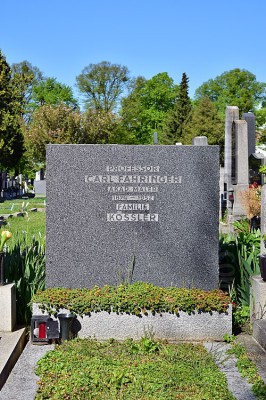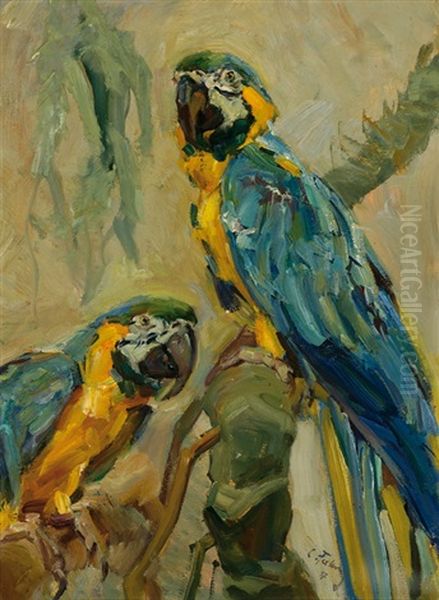
Carl Fahringer stands as a significant figure in Austrian art history, bridging the late 19th and mid-20th centuries. Born in Vienna in 1874 and passing away in 1952, his life spanned a period of immense artistic change. Primarily celebrated for his evocative animal paintings and vibrant landscapes, Fahringer is closely associated with the Austrian Impressionist movement. His work is characterized by a keen observation of nature, a dynamic use of color, and the profound influence of his extensive travels.
Early Life and Academic Foundations
Carl Fahringer's artistic journey began in his birthplace, Vienna, the vibrant capital of the Austro-Hungarian Empire. He was born on December 24, 1874. Recognizing his talent and inclination towards the arts, he enrolled in the prestigious Vienna Academy of Fine Arts (Akademie der bildenden Künste Wien). During his formative years there, he studied under notable professors such as Sigmund L'Allemand and August Eisenmenger, who provided him with a solid grounding in academic drawing and painting techniques.
Seeking to broaden his artistic horizons, Fahringer later moved to Germany to continue his studies at the Munich Academy of Fine Arts (Akademie der Bildenden Künste München). In Munich, a major center for artistic innovation at the time, he studied under the guidance of Carl von Marr. It was during his time in Munich that Fahringer began to truly develop the foundations of his Impressionist color style, learning to capture the fleeting effects of light and atmosphere with a brighter palette and looser brushwork. This period was crucial in shaping his approach to color and composition.
The Transformative Power of Travel
Upon completing his formal education around 1901, Carl Fahringer embarked on extensive travels that would deeply shape his artistic vision and subject matter. His journeys took him far beyond the borders of Austria and Germany. He explored various parts of Europe, including Italy, Slovenia, Serbia, Macedonia, Turkey, and Romania. These early trips exposed him to diverse cultures, landscapes, and ways of life, particularly in Eastern Europe and the Balkans.

Fahringer was especially captivated by what the source material describes as the "vibrant Oriental life" he encountered, particularly in the Bosnian region. The bustling markets, the distinct local attire, the unfamiliar architecture, and the intense light and color of these regions provided him with a wealth of inspiration. This fascination with the 'Orient', as perceived through a European lens of the time, infused his work with exotic themes and a heightened sense of color and dynamism.
His wanderlust did not cease there. Later in his career, Fahringer's travels extended even further, taking him to parts of Africa and the Dutch East Indies, including Java, Bali, and Sumatra. These experiences provided him with firsthand encounters with tropical flora and fauna, which became central subjects in his later work, particularly his renowned animal paintings. The diverse environments, from Balkan towns to tropical jungles, continuously refreshed his perspective and provided new challenges for his Impressionist techniques.
Evolution of an Impressionist Style
Carl Fahringer's artistic style evolved significantly throughout his career, though it remained rooted in the Impressionist principles he absorbed during his studies, particularly in Munich. His early works likely reflected the more academic training received in Vienna, but his exposure to Impressionism and his travels pushed him towards a more personal and expressive style.
The foundation laid in Munich emphasized a rich use of color. Fahringer became adept at capturing the interplay of light and shadow, and the inherent color richness found in scenes like bustling marketplaces or groups of people under strong sunlight. He wasn't strictly an Impressionist in the French mold, but rather adapted its techniques to his own interests, particularly landscape and animal subjects. His approach often combined Impressionist brushwork and color theory with a strong sense of form and structure.
His travels provided constant stimulus for his exploration of color. The intense light of the Mediterranean, the Balkans, and later, the tropics, encouraged a brighter palette and bolder color contrasts than might be typical of Austrian landscapes alone. He sought to convey the atmosphere and energy of the places he visited, using color not just descriptively but also emotionally. This focus on vibrant, expressive color became a hallmark of his work, whether depicting a sun-drenched landscape or the plumage of an exotic bird.
A Celebrated Painter of Animals
While accomplished in landscape painting, Carl Fahringer achieved particular fame for his animal paintings (Tierbilder). He possessed a remarkable ability to capture the essence and vitality of his animal subjects. His travels provided ample opportunity to observe and sketch animals in their natural habitats or within the context of human activity, such as market scenes or zoos. He depicted a wide range of creatures, from domestic animals and European wildlife to the exotic birds and mammals encountered on his journeys further afield.
His animal works are characterized by dynamic compositions, confident brushwork, and a sensitive understanding of animal anatomy and behavior. He didn't merely render their forms accurately; he imbued them with a sense of life and movement. His Impressionist handling of light and color played a crucial role here, helping to integrate the animals into their environments and highlighting the texture of fur or feathers. The period between 1929 and 1945 is noted as a particularly strong phase for his animal painting.
Specific examples mentioned in the source material highlight this focus. His work Two Parrots, dated 1947, demonstrates his continued interest in exotic subjects late in his career. This painting was estimated at €4,000-€6,000 at a 2015 auction, indicating the continued market interest in his work. Another significant piece is A Parrot Among Exotic Plants, created in 1946. This work, featuring a vividly colored bird amidst lush, perhaps tropical foliage, exemplifies his skill in combining animal subjects with rich environmental details, likely inspired by his travels to places like the East Indies.
Another painting mentioned, titled Son, is described as having blue tones inspired by sunlight reflecting off snow. While not strictly an animal painting, this description points to Fahringer's keen interest in capturing specific light effects and color phenomena observed in nature, a sensibility that informed all aspects of his work.
Academic Role and Lasting Influence
Beyond his personal artistic practice, Carl Fahringer made significant contributions as an educator. He held the position of Professor at the Vienna Academy of Fine Arts, the same institution where he had begun his studies. His tenure as a professor lasted for a considerable period, noted in the source material as running from 1929 until 1945. During this time, he mentored a new generation of Austrian artists.
His role as an educator extended his influence within the Austrian art scene. Among his known students were figures like Emil Rizek. Rizek, after his studies with Fahringer and others in Vienna, also undertook significant travels, particularly to the Dutch East Indies (Java, Bali, Sumatra), mirroring his teacher's interest in these regions and producing art inspired by his experiences there. This suggests Fahringer may have encouraged his students to seek inspiration through travel and direct observation.
Another documented student was the Dutch painter Wouter IJdo from Hoorn. The connection extends further, as IJdo himself later became a teacher, instructing Bart van Oijen. This lineage demonstrates how Fahringer's influence, transmitted through his students, could ripple outwards, even reaching the art scene in the Netherlands. His teaching likely emphasized the importance of solid technique combined with the expressive potential of Impressionist color and direct engagement with the natural world.
Contemporaries and Artistic Context
Carl Fahringer worked during a vibrant period in Austrian and European art. While the provided text doesn't detail direct collaborations or intense rivalries, it places him within a network of artistic relationships and influences. His teachers – Sigmund L'Allemand, August Eisenmenger, and Carl von Marr – were established figures who connected him to the academic traditions of Vienna and Munich.
His students, Emil Rizek and Wouter IJdo (who taught Bart van Oijen), represent the direct transmission of his artistic principles. The text also mentions an indirect link involving Roland Strasser and Willem Dooijewaard. It suggests Strasser, who had some connection to Fahringer (though the nature of this link isn't specified in the source), influenced Dooijewaard's style in the 1920s. This hints at the complex web of influences that often characterizes artistic communities.
To fully understand Fahringer's context, it's helpful to consider other prominent Austrian artists active during his time, even if not directly mentioned as collaborators or competitors in the source. Figures associated with Austrian Impressionism or landscape painting include Tina Blau and Olga Wisinger-Florian, who were pioneers in landscape painting and capturing atmospheric light, known as 'Stimmungsimpressionismus'. While their focus might have differed from Fahringer's emphasis on animals, they were part of the broader artistic milieu in Vienna.
Furthermore, considering his studies in Munich and his focus on animal painting, the influence of German animal painters ('Tiermaler') like Heinrich von Zügel, a prominent professor in Munich during the era Fahringer might have been there or shortly after, could also be considered part of his wider artistic context, even if not a direct teacher mentioned in the source. Fahringer operated within this rich environment, developing his unique voice while engaging with the prevailing artistic currents of his time.
Legacy, Recognition, and Collections
Carl Fahringer's artistic achievements earned him considerable recognition during his lifetime and continue to be appreciated today. He established himself as a leading Austrian painter, particularly renowned for his specialization in animal subjects rendered with an Impressionist sensibility. His ability to capture the vitality of animals and the atmosphere of diverse landscapes, often informed by his extensive travels, set his work apart.
His reputation is evidenced by his long tenure as a professor at the prestigious Vienna Academy and the success of his students. Furthermore, his works were exhibited internationally. The source mentions his painting A Parrot Among Exotic Plants being shown at the 32nd Paris Drawing Fair (Salon du Dessin), indicating his participation in the wider European art market.
His paintings continue to appear at auctions, demonstrating ongoing collector interest. The example of Two Parrots (1947) with its auction estimate in 2015 attests to the enduring value placed on his work. While the source material doesn't provide a comprehensive list of institutions holding his works, it does specify that A Parrot Among Exotic Plants (1946) is held by the Martin Moeller & Cie institution, located in Hamburg, Germany (Johnsallee 11, D-20148 Hamburg). This suggests his works are present in significant private galleries or collections beyond Austria.
Carl Fahringer passed away on February 4, 1952, at the age of 78. He left behind a substantial body of work that reflects his dedication to capturing the natural world, his mastery of color and light, and the enriching impact of his global travels. He remains an important figure for understanding the development of Austrian Impressionism and the tradition of animal painting in the early 20th century. His legacy resides in his vibrant canvases and in the influence he exerted as a respected artist and educator.